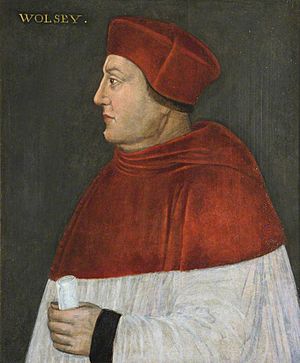Treaty of London (1518) facts for kids
The Treaty of London was an important agreement signed in 1518. It was like a big promise among the main countries in Europe. These countries included England, France, Spain, the Holy Roman Empire, and others. They all agreed not to fight each other. They also promised to help any country that was attacked.
This treaty was mainly put together by Cardinal Wolsey, a powerful advisor to the King of England. The Pope at the time, Pope Leo X, wanted a five-year peace. He hoped European leaders would help him fight the growing power of the Ottoman Empire. But Wolsey wanted a longer, lasting peace. He convinced Henry VIII, the King of England, to choose diplomacy instead of war.
Why the Treaty Was Needed
For about 50 years before this treaty, there was mostly peace in Italy. Italy was made up of many small city-states. There was only one small war during this time. It was between the Republic of Venice and the Papal States over control of Ferrara.
However, this peaceful time ended in 1494 when France invaded Italy. After that, many small wars broke out. By 1518, everyone hoped a peace treaty could finally bring an end to the fighting.
What the Treaty Said
All the major European countries were invited to London for the treaty. The goal was to get about 20 leading states in Europe to agree to peace. This would stop wars between them.
In October 1518, England and France first started the treaty. Then, other European countries and the Pope officially agreed to it. The agreement created a group of countries that would defend each other. The main idea was that countries with active plans for other nations had to promise not to attack. Also, if any country broke the treaty, all the other countries would join together to fight them.
At the time, this treaty was seen as a huge success for Thomas Wolsey. It helped Henry VIII become much more important in European politics. England was then seen as a third major power, though still smaller than the Holy Roman Empire and France.
What Happened After
The peace brought by the treaty did not last very long. Wars started again just a few years later. For example, there were wars between Denmark and Sweden. Also, England and Spain formed an alliance against France.
However, the idea of peace continued to grow over the next centuries. It became a big part of the Age of Enlightenment movement in the 1700s.
See also
 In Spanish: Tratado de Londres (1518) para niños
In Spanish: Tratado de Londres (1518) para niños
- List of treaties
- Other Treaties of London
- George of Poděbrady for an earlier idea like this treaty



